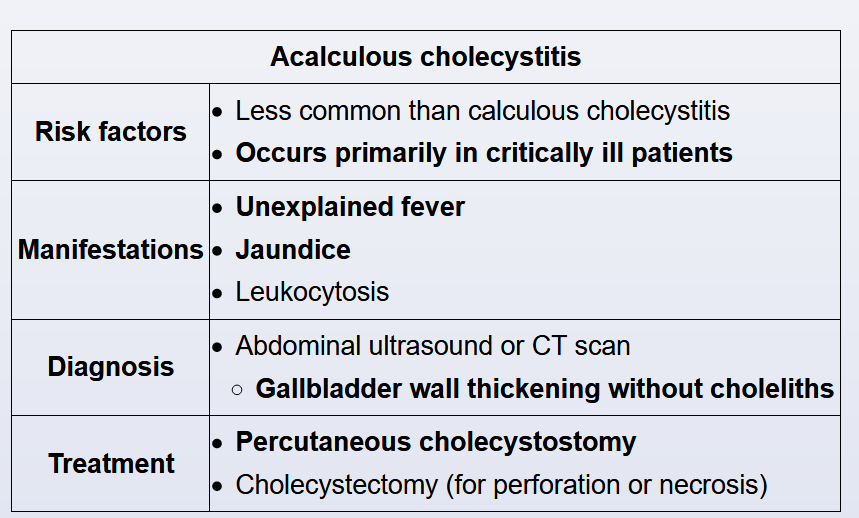acalculous cholecystitis
- related: GI
- tags: #note
This patient in the intensive care unit has fever with CT scan evidence of acalculous cholecystitis.
Acalculous cholecystitis is due to gallbladder stasis with resultant ischemia of the gallbladder wall. Most cases occur in the hospitalized setting, particularly in patients who are critically ill. Suspicion is often raised when a hospitalized patient develops unexplained fever, leukocytosis, and jaundice. Unlike calculous cholecystitis, acalculous cholecystitis is usually accompanied by elevated bilirubin, alkaline phosphatase, and transaminases.
The diagnosis of acalculous cholecystitis is typically confirmed when abdominal ultrasound or CT scan of the abdomen reveals gallbladder wall thickening with no choleliths or biliary tree dilation. Treatment with intravenous antibiotics (after blood cultures) and placement of a percutaneous cholecystostomy tube usually results in improvement within 24 hours.

Acalculous cholecystitis typically occurs in critically ill patients and is a result of gallbladder ischemia that can be complicated by enteric bacterial infection. Risk factors for this condition include cardiac and aortic surgery, sepsis, burns, and vasculitis. The presentation depends on whether the patient is alert or sedated and mechanically ventilated. In alert patients, the presentation is pain, as seen in cholecystitis related to gallstones. In sedated or mechanically ventilated patients, it may present with leukocytosis, jaundice, and sepsis. The diagnosis is made using ultrasonography, which may show gallbladder wall thickening, pericholecystic fluid, gallbladder distention, or gallbladder-wall pneumatosis in the absence of calculi. In this setting, the gallbladder may not be visualized on a hepatobiliary iminodiacetic acid scan.
Treatment consists of empiric intravenous antibiotics to cover enteric bacteria and cholecystectomy. A cholecystostomy tube may be needed if the patient is unstable or a poor candidate for surgery. The role of endoscopic gallbladder drainage is evolving. The mortality rate for untreated acalculous cholecystitis is as high as 75%.